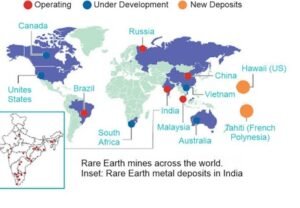
About Rare Earth Elements (REEs)
-
Group of 17 chemical elements:
-
Includes 15 lanthanides.
-
Plus scandium and yttrium.
-
-
Abundance:
-
Found in the Earth’s crust in relatively high amounts.
-
Present in low concentrations and mixed with other minerals.
-
Extraction is difficult and costly.
-
-
Types:
-
Light REEs (LREEs): More abundant.
-
Heavy REEs (HREEs): Less abundant, more critical due to high demand and low availability.
-
-
Key Examples:
-
LREE – Neodymium: Critical for mobile phones, medical equipment, EVs.
-
HREE – Dysprosium, Yttrium, Cerium: Important for clean energy technologies but have smaller markets due to supply limits.
-
-
Misleading Name:
-
“Rare” refers to economic viability, not physical scarcity.
-
Applications of REEs
-
Electronics:
-
Smartphones, laptops, flat-panel displays, headphones.
-
Used for magnetic and phosphorescent properties.
-
-
Clean Energy:
-
High-performance magnets for wind turbines, EVs, solar panels.
-
-
Defence:
-
Precision-guided missiles, radar, sonar, jet engines.
-
-
Medical Technology:
-
MRI, PET scanners, radiation-based cancer treatments.
-
-
Industrial Use:
-
Petroleum refining, glass polishing, corrosion-resistant alloys.
-
India’s Position in REEs
-
Reserves:
-
Holds around 6% of global REE reserves (untapped potential).
-
-
Imports:
-
Imported 2,270 tonnes in FY 2023–24, showing moderate external dependency.
-
-
LREE Extraction:
-
Can extract LREEs from monazite-rich beach sands in Kerala.
-
-
HREE Refining Gap:
-
Lacks technology and infrastructure for heavy REE refining.
-
Creates a strategic vulnerability.
-




